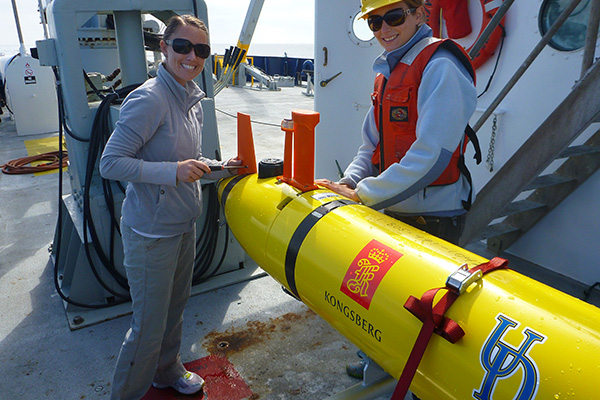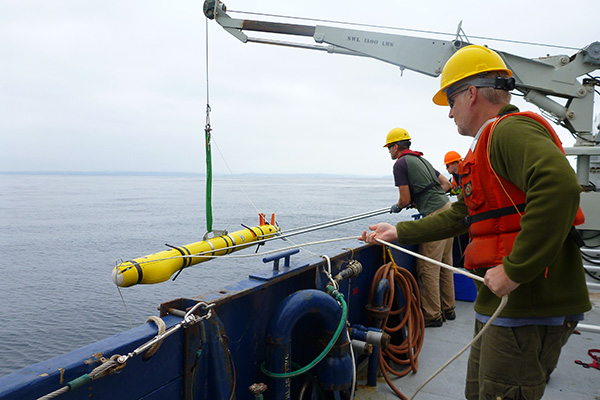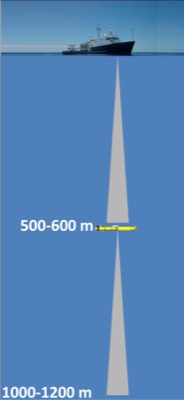Whale of a difference
Researchers double depth at which technology can identify whale prey
11:19 a.m., Sept. 26, 2013--Shipboard echosounders can help scientists find and identify life in the ocean, from schools of fish to diving seabirds and even flurries of tiny krill.
The sound-generated images from ships also reveal squid, a favorite meal for beaked and sperm whales. That is, until they swim deeper than about 600 meters below the surface — and right out of the ship equipment’s range.
Research Stories
Chronic wounds
Prof. Heck's legacy
Mark Moline, director of the School of Marine Science and Policy within UD’s College of Earth, Ocean, and Environment (CEOE), and Kelly Benoit-Bird of Oregon State University have devised an innovative way to address that problem. They customized technology from ships to fit inside an underwater robot that can dive to greater depths, effectively doubling the echosounder’s reach.
“A lot of the action, especially in terms of whales, is happening deeper,” Moline said. “Anything we learn about their prey will help inform others about conservation efforts.”
The echosounder bounces sound at two frequencies, 38 kHz and 120 kHz, through the water to surrounding objects and measures the return time. The ratio of the return signal helps identify specific organisms and their locations. Echosounders used on ships and in the underwater robot are high in frequency and do not impact whale behavior.
Moline and Benoit-Bird received a $1.5 million grant from the Strategic Environmental Research and Development Program last year to develop the new technology and map the movement of whales and the squid they eat.
Benoit-Bird, an expert on foraging behavior in the ocean and a MacArthur Fellow, uses marine acoustics to examine the distribution of predators and prey in the sea. In particular, she is interested in how predators deal with such patchy availability of food through wide expanses.
The researchers retrofitted a ship echosounder into a long, waterproof robot programmed to move through the ocean and collect scientific data, called an autonomous underwater vehicle (AUV). The instruments are designed to sit in a lab, controlled by people and a large computer — not squeezed into a confined space.
“Miniaturizing everything and making it work by itself without fail for days at a time was a challenge,” Benoit-Bird said.
The AUV can maneuver down to 600 meters, with the echosounder extending through the water another 600 meters for a total squid-detection capability of up to 1,200 meters — or three-quarters of a mile. Compared with sonar more commonly used in AUVs to map the seafloor, the echosounders in the researchers’ new configuration are much more sensitive and can make out shapes as small as 4 centimeters long.
Benoit-Bird added computers on-board to not just record the acoustic readings, but also quickly process the information and determine whether the signals show squid. If so, the AUV automatically reroutes its course to hone in on the surrounding environment and check for other squid in the area.
“If we just did one big line, it wouldn’t necessarily give us that sense of how patchy prey fields are,” Moline said. “One critical thing we’re trying to see is how organisms are organized at those depths.”
The scientists tested the equipment in April in California at two different depths with successful results. They found, in fact, that there was much less background noise and the imagery was much cleaner than typically seen on ship-mounted echosounders.
This month the researchers are at sea on a research cruise using the equipment off the coast of San Diego, joined by CEOE graduate students Megan Cimino and Danielle Haulsee, who have used underwater vehicles to learn about penguin and shark behavior. (See above to watch a video of their AUV launch.)
The team is working with colleagues who tag and track whales, cross-referencing their echosounder data on squid sightings with known whale locations. The hope is that the combined data will shed light on whale feeding behavior.
After the experiment, the researchers may use the equipment to conduct field research in the Bahamas, where scientists are already intensively tagging all the different types of whales and known distribution patterns of various species.
“The field is at a stage where biologists know where these organisms are, and they’re starting to map where whales are spending the most time, where they’re spending the least time, how they’re diving and how they’re utilizing the environment,” Moline said. “But they do not necessarily know the connection with the prey. As soon as you start answering those questions, you may be able to inform decisions about conserving certain areas relied upon by whales.”
Article by Teresa Messmore
Photos by Mark Moline and Megan Cimino
Image courtesy of Mark Moline














